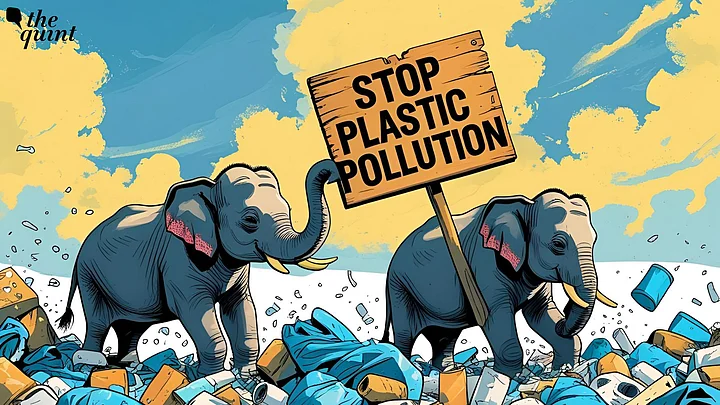The title of this article sounds like an epic David vs Goliath story, but in this case, the mighty elephants are, in a sense, the Davids, fighting against the Goliath-like threat of plastic.
Much has been written about the harmful effects of plastic on our environment, ranging from soil pollution to water pollution, and even microplastics in our food.
An aspect that is rarely discussed is the effect of plastics on India’s National Heritage Animal—the charismatic Asian elephant (Elephas Maximus).
Already endangered and struggling to survive amid shrinking habitats and rising human-wildlife conflict, these gentle giants now face an insidious new threat: plastic.
From garbage dumps along forest edges to snack wrappers tossed beside railway tracks, the elephant’s world—like that of many other unsuspecting wild animals—is becoming increasingly entangled in, and endangered by, plastic waste.
When The Hungry Elephant Finds the Plastic Feast
In May, a wild female elephant was found collapsed in a key elephant corridor in Tamil Nadu's Coimbatore district. She was rescued, but despite three days of intensive care, she died.
The autopsy revealed she was pregnant and, alarmingly, her digestive tract contained a large amount of plastic—evidence of prolonged ingestion of harmful non-biodegradable waste that likely contributed to her death.
Tragically, cases like this are becoming increasingly common.
Elephants have a relatively inefficient digestive system, which means they can only process about half of what they eat. These animals need to eat almost throughout the day, spending up to 16 hours a day feeding.
Coupled with their inefficient digestive system is their tendency to explore novel food sources, such as crops and food waste, which creates a recipe for disaster.
While feeding on crops jeopardises the livelihood of thousands of families in India each year, the elephant’s dependence on food waste triggers potentially fatal impacts on elephant health.
According to the Central Pollution Control Board’s 2022–23 annual report, India generates around 4 million tonnes of plastic waste every year. This is roughly equivalent to the weight of 1 million elephants.
With fewer than 50,000 Asian elephants left in the wild today, that’s about 80 tonnes of plastic waste for every elephant roaming free.
India is home to 60 percent of the world’s population of this species.
As elephants increasingly range close to human settlements and farms in search of food, plastic invariably finds its way into the diet of these animals.
Garbage dumps near forest areas and elephant corridors are particularly harmful, as these dumps not only attract elephants but also other wildlife, such as leopards, which are drawn to the sites where domestic dogs and pigs feed.
The presence of elephants close to these garbage dumps also poses a health hazard to people due to the risk of accidental encounters.
Inefficient waste management in rural India, combined with the high prevalence and popularity of plastic-wrapped food items, exacerbates these challenges.
Especially, packets of snacks containing high sodium content attract elephants as these animals try to meet their salt requirements from these sources.
How Plastic Waste Leads to Wildlife Deaths
As the plastic food wrappers enter the gut of these animals, their normal gut functioning gets severely impaired, even leading to death when plastics block the digestive system entirely.
Plastic wrappers also indirectly contribute to the accidental mortality of elephants along highways and railways that pass through forest areas.
Packets of wafers carelessly tossed outside the window from a moving bus or train attract elephants and other wildlife. As elephants spend more time feeding on these along railway lines and highways, the risk of accidental collisions increases significantly.
Each year, 12-15 elephants die in India due to accidental collisions with railways. A large proportion of these accidents could be averted by adopting simple plastic disposal practices among train passengers.
Globally, plastics present a nearly insurmountable problem that impacts our ecosystems and human lives. Discarded plastic bottles, wrappers, and bags end up in landfills or our rivers and oceans.
As plastics do not decompose naturally, they continue to accumulate. The Great Pacific Garbage Patch is a 1.6 million square kilometre floating island (half the size of India) in the Pacific Ocean. Microplastics from these aggregations enter fish and ultimately end up in the human body when these fish are consumed.
From tiny fishes in the oceans to giant elephants in terrestrial ecosystems, our wild denizens are prone to adverse impacts from plastics. This requires sustainable alternatives.
Some of the changes can also be behavioural and depend on how we, as a society, deal with this problem.
Being mindful of the perils associated with plastic use is a good starting point.
Reverting to the use of cloth bags for grocery shopping, limiting the use of packaged products, and reducing plastic use in everyday life can have a significant impact on plastic waste production.
Sustainable alternatives from organic sources, such as jute and other fibres, can stall the plastic Armageddon that we are inevitably heading towards.
Stringent regulations for the production and use of plastics, combined with thorough plastic-trail audits of manufacturers, can curb the widespread use of plastics.
Careful segregation of plastic waste near forest-adjacent areas and along rivers and water bodies can go a long way in preventing the untimely deaths of elephants and other threatened wildlife, and can also help prevent adverse human-wildlife interactions.
(Aritra Kshettry leads WWF-India's Elephant Conservation Program. A conservation ecologist by training, Aritra has a keen interest in evidence-based and inclusive approaches towards biodiversity conservation across large landscapes. This is an opinion piece and the views expressed above are the author’s own. The Quint neither endorses nor is responsible for the same.)
